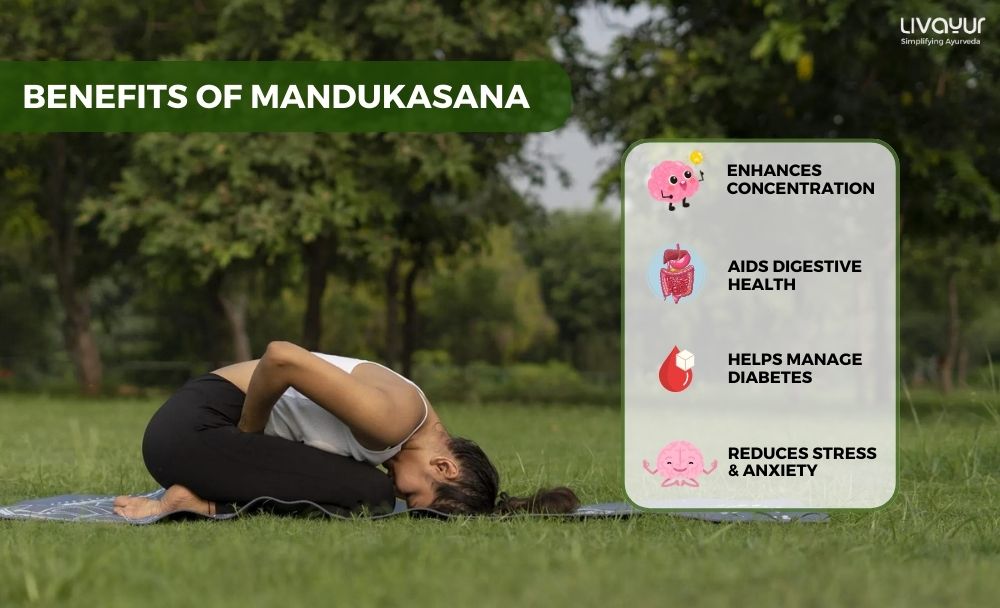
Mandukasana, also known as Frog Pose, is a yoga asana that mimics the posture of a frog. This pose is particularly beneficial for stretching the hips and is traditionally thought to stimulate the Svadisthana chakra, which holds significance as the second primary chakra. This chakra is associated with the opening of the spleen and the sacrum, located at the base of the spine between the hips. Representing the center of pleasure, enjoyment, and creativity, the Svadisthana chakra contributes to improved productivity, concentration, and a more profound sense of self-acceptance. [1] Also, activating the Svadisthana chakra through yoga poses like Mandukasana can increase happiness and contentment.
Mandukasana also impacts the Doshas and is beneficial for balancing the Samana Vata, Pachaka Pitta, and Ranjaka Pitta. It is an excellent balancer of Apana Vata and Udana Vata, as evidenced by its effect on the reproductive system and heart health. [3]
This article will delve into the Uttana Mandukasana benefits and provide a comprehensive step-by-step guide on practicing it.
Benefits of Mandukasana
Enhancing Concentration through Mandukasana:

Mandukasana can be a solution if you are struggling to focus at work. As you settle into the frog pose, your attention becomes finely attuned to the nuanced adjustments and motions required to maintain a comfortable alignment of your hips, knees, and feet. These deliberate movements engage your muscles and heighten your awareness of bodily actions.
Promoting Stability with Mandukasana:
The Uttana Mandukasana pose exerts pressure on the spine, lower back, and groin area, activating the Muladhara chakra at the base of the spine. This activation fosters a sense of physical and mental stability, contributing to overall well-being. It can cultivate emotional equilibrium and spiritual harmony in an individual’s life.
Managing Diabetes through Mandukasana:

For those grappling with elevated blood sugar levels, the practice of Mandukasana might aid in diabetes management. Research indicates that assuming the frog pose could increase insulin production, potentially assisting in regulating sugar levels within the body.
Improving Digestive Health with Mandukasana:
The advantageous effects of the frog pose could also extend to stimulating the solar plexus, commonly referred to as the Manipura chakra. Nestled within the navel region, this activation of the abdominal organs can be felt as pronounced pressure in the stomach area during Mandukasana. The resultant core pressure triggers internal organs, augmenting metabolic activity, facilitating bowel movements, promoting the secretion of digestive fluids, and aiding in relieving gas and constipation.
Alleviating Depression, Anxiety, and Stress with Mandukasana:
In the pursuit of tranquility and stress relief, Mandukasana yoga emerges as a potential ally. This asana involves stretching and opening the lower back, hips, and pelvis, fostering the release of pent-up energies such as anxiety, depression, and stress. Engaging in the frog pose can effectively disperse accumulated negative emotions, generating feelings of rejuvenation and joy. Furthermore, enhanced blood circulation and improved oxygen supply enhance this sense of renewal.
Additional Benefits of Mandukasana:
Encouraging Self-Motivation and Empowerment: Stimulating the solar plexus chakra, Mandukasana benefits include instilling a sense of self-motivation and empowerment, ultimately enhancing personal efficiency.
Easing Back Pain: Mandukasana’s elongating effects on the back, hips, knees, and ankles can alleviate back pain by promoting blood flow and relieving sciatica discomfort.
Aiding in Abdominal Fat Reduction: By generating pressure on the abdominal area, Mandukasana potentially aids in shedding fat accumulated in the lower belly region.
Alleviating Cramps and Pain: By clearing blocked energy and restoring balance to the body and mind, the benefits of Mandukasana include offering relief from cramps and bodily discomfort.
How to Do Mandukasana (Frog Pose) Step by Step:
Step 1: Starting Position
Mandukasana steps begin by assuming a tabletop position on all fours. Align your shoulders over your wrists and your elbows and knees over your hips.
Step 2: Widening the Knee Distance
Gradually spread your knees apart to a comfortable extent without straining. Bend your knees at a 90-degree angle, ensuring that the inner arches of your feet make contact with the ground while your toes point away from your body.
Step 3: Lowering onto Forearms
As you exhale, lower your forearms down to the ground. Maintain a shoulder-width distance between your elbows, and align your shoulders directly above your elbows. Place your palms on the earth with your fingers spread wide.
Step 4: Lengthening the Spine
Inhale as you elongate your spine. Reach your head’s crown forward while extending your tailbone in the opposite direction.
Step 5: Engaging the Core and Hips
Engage your core gently by drawing your navel inward and upward toward your spine. Soften your chest and torso toward the ground, simultaneously shifting your hips backward and downward.
Step 6: Mindful Breath
If you begin to experience intensity in this posture, redirect your attention to your breath. Focus on deepening and slowing down your breathing to create a sense of ease.
Step 7: Releasing the Pose
To exit the pose, lift your forearms off the ground and place your palms back on the floor. Gradually move your hands toward your hips. As you do this, gently bring the soles of your feet together behind you. Draw your knees together and sit your buttocks onto your feet.
By following these steps mindfully and paying attention to your breath and body, you can experience the benefits of Mandukasana yoga while ensuring safe and comfortable practice. [2]
FAQs
• Does Mandukasana aid in digestion?
Yes, Mandukasana initiates the activation of the Manipura chakra, situated within the abdominal area. This activation stimulates the organs of the abdomen, subsequently contributing to the enhancement of digestive functions.
• When should we avoid Mandukasana?
Avoid Mandukasana (Frog Pose) if you have wrist, knee, or hip injuries. Pregnant individuals, those with high blood pressure, and recent abdominal surgery should also refrain. If you are dealing with digestive disorders, hernia, or heart issues, consult a professional before attempting the pose.
• How many repetitions of Mandukasana are recommended?
You can engage in approximately 5 to 6 repetitions of the Mandukasana posture, holding each iteration for about five to ten breaths. However, it is advisable to seek guidance from a qualified yoga instructor who can provide personalized recommendations concerning the number of rounds suitable for your practice.
Conclusion
Incorporating Mandukasana into your regular yoga routine can offer many physical and mental benefits, from improved concentration and stability to better digestive health and emotional well-being. Mandukasana also has the potential to heighten focus, promote stability, and alleviate negative energies such as stress and anxiety through the activation of the Muladhara and Manipura chakras.
Disclaimer:
This article is written from a health and wellness perspective and is not medical advice. Kindly seek the help of a certified medical practitioner before initiating any treatment.
References:

















